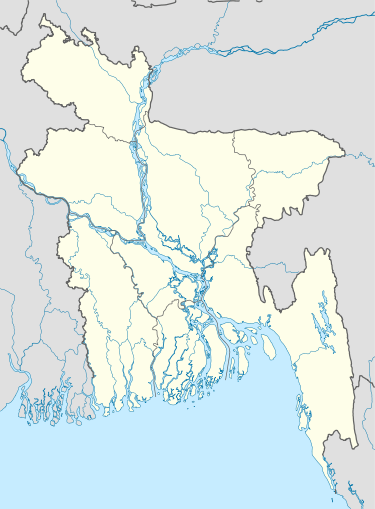Baksiganj Upazila
| Baksiganj বকশিগঞ্জ | |
|---|---|
| Upazila | |
 Baksiganj Location in Bangladesh | |
| Coordinates: 25°13.5′N 89°52.5′E / 25.2250°N 89.8750°ECoordinates: 25°13.5′N 89°52.5′E / 25.2250°N 89.8750°E | |
| Country |
|
| Division | Dhaka Division |
| District | Jamalpur District |
| Area | |
| • Total | 204.3 km2 (78.9 sq mi) |
| Population (1991) | |
| • Total | 157,403 |
| • Density | 770/km2 (2,000/sq mi) |
| Time zone | BST (UTC+6) |
| Postal code | 2140 |
| Website | Baksiganj Upazila |
Baksiganj (Bengali: বকশিগঞ্জ) is an Upazila of Jamalpur District in the Division of Dhaka, Bangladesh.
Bakshigonj is located at 25.2250°N 89.8750°E . It has 32007 units of household and total area 204.3 km².
Administration Bakshigonj thana was turned into an upazila in 1982. The upazila consists of 7 union parishads, 25 mouzas and 196 villages. In Bakshigonj have some Haat Bazer.
Bakshigonj (Town) The area of the Bakshigonj town is 3.86 km². It has a population of 8573; male 50.97%, female 49.03%; population density is 2220 per km². Literacy rate among the town people is 25.9%.
Historical events during the war of liberation the Pakistan army established a military camp at Kamalpur, in the northern sector. From the point of view of war strategy this camp was so important that its fall meant to lose control over the whole Jamalpur-Dhaka region. The freedom fighters attacked Kamalpur many times. On 31 July 1971 the freedom fighters attacked Kamalpur under the command of Major Moinul Hussain Chowdhury, Battalion Commanding Officer of the 1st East Bengal Regiment of Sector 11. This time final victory was not achieved but the casualties in the Pakistan army were huge. In this battle 35 freedom fighters including Captain Salahuddin Momtaz, Ahaduzzaman and Abul Kalam Azad were killed. On 14 November 1971 Abu Taher lost one of his legs in an explosion.
Marks of War of Liberation Mass grave 7, Playground of Bakshigonj High School, Kamalpur Health Centre, Kamalpur Bazar, Battajor, Dhanua Bakshigonj Cattle Hat, Bakshigonj Bazar.
Data
Population180405 ; male 50.80%, female 49.20%; Muslim 98.08%, Hindu 1.25%, Christian 0.44%, and others 0.22%.
Religious institutions Mosque 287, temple 1.
Literacy and educational institutions Average literacy 17.4%; male 22.8%, female 11.8%. Educational institutions- college 3(One is Bakshigonj Govt K.U. College, Khatamun Moin Women's College at (near Boro Bari/ Pakhimara at Jamalpur Road) ] and Niloxkhia College), secondary school 13, Bakshigonj Nur Muhammad high school (near the famous Miah Bari of Mokbul Hossain Siddiqi), madrasa 46, government primary school 49, non-government primary school 60.
Cultural organisations Rural club 27, cinema hall 2,(one about to close), literary society 6, women's organisation 1, play ground 22.
Main occupations Agriculture 40.46%, fishing 1.28%, agricultural labourer 26.24%, wage labourer 2.95%, commerce 12.92%, service 13.08% and others 3.07%.
Land use Total cultivable land 14885.88 hectares, fallow land 2747.88 hectares; single crop 9.36%, double crop 56.22% and treble crop land 34.42%.
Land control Among the peasants 21.21% are landless, 30.07% marginal, 31.12% small, 14.52% intermediate and 3.08% rich.
Value of land The market value of the land of the first grade is 30000 Taka per 0.01 hectare(depend on Area).
Main crops Paddy, jute, sugar cane, mustard seed, wheat, sweet potato, turmeric, onion, garlic, cabbage, cauliflower, brinjal, pulse and vegetables.
Extinct or nearly extinct crops Linseed, sesame, kaun, corn and peanut.
Main fruits Banana, black berry, papaya, pine apple and water melon.
Fisheries, dairies, cattle breeding centre 2, poultry farm 16, hatchery 3.
Communication facilities Roads: pucca road 36 km, semi pucca 19 km, mud road 106 km.
Traditional transport Palanquin, horse carriage and bullock cart. These means of transport are either extinct or nearly extinct.
Cottage industries Loom 1700, handicrafts 36, blacksmiths 98, potteries 9, bamboo and cane works 355, wood workers 132, jute and cotton works 16.
Hats, bazaars and fairs hats and bazaars are 5, most noted hat is Nayem Mia Hat. It is a bit far from Thana but it a really classic hat.
Main exports Jute, paddy, cotton, mustard seed, onion, garlic and turmeric.
NGO activities Operationally important NGOs are BRAC, ASA, Grameen Bank, CARE, Unnayan Sangha and Jibika.
Health centres Upazila health complex 1, family planning centre 7, satellite clinic 3.
Well, Bakshiganj has some places for visit or tour including the locally famous Louchapra Picnic spot. There are some guest houses there where you can enjoy a lot of undiscovered hills, with in a touch of very simple local tribal people. There is a bazaar near there called Louchapra Bazaar.
Demographics
As of the 2011 Bangladesh census, Baksiganj has a population of 180503. Males constitute 50.8% of the population, and females 49.2%. This Upazila's eighteen up population is 76635. Baksiganj has an average literacy rate of 17.4% (7+ years), and the national average of 32.4% literate.[1]
Administrative
Baksiganj thana was turned into an upazila in 1982. The upazila consists of 7 union parishads, 25 mouzas and 196 villages Baksijang thana has a remarkable development throughout the years. The key developer of this thana are MA Sattar Ex:Minister of BD Govt.Mr. Nazrul Islam Adv Mr. Akkas Master, Mr. Hamidur Rahman, Abdur Rauf Talukdar and a lot of people who are giving their valuable time to Develop the Upazila. Among others philanthropist Alhaj Mohammad Mainuddin contributed significantly in establishing Bagrasha school in Sherpur town in 1921 and later several institutions including girls school and colleges in collaboration with other donors in Bakshigonj region. Former MLA Naim Uddin Ahmed, Chief Engineer of the then East Pakistan Md. Abdul Jabbar, Md. Mokbul Hossain Siddiqi, Md. Samu Miah (Siddiqui), local marchant and politician Md. Mafizal Haque Talukder, Professor Rashiduzzaman, Professor Dr. Ekramul Islam, Ex. MP Md. Ashraf Hossain Advocate, Minister Md. Abul Kalam Azad among others leaded various development projects in the region.
See also
References
- ↑ "Population Census Wing, BBS.". Archived from the original on 2005-03-27. Retrieved November 10, 2006.
